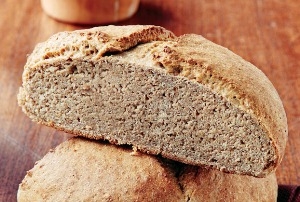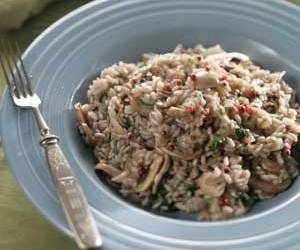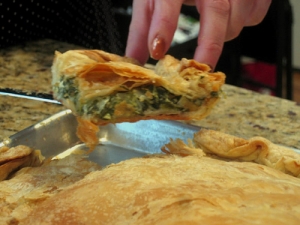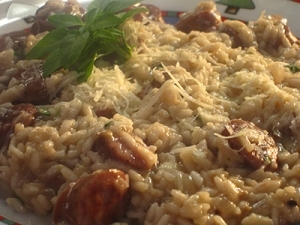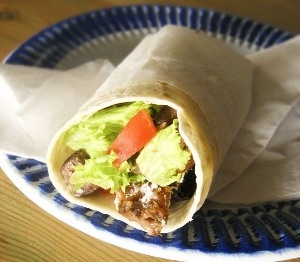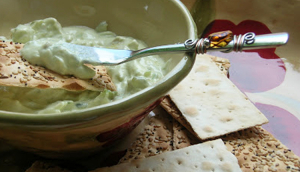I am not a fan of junk food, hence the name of the blog, apart from Greek souvlaki with gyros, the famous street food, the only food of Greece I really missed when studying abroad. There is something magical about the soft pita bread, the crispy, salty pork slivers and the juicy bits in between (tzatziki, tomato, onions, mustard, fries) which makes my mouth water.
It is also one of the few things I do not make at home, first of all because it is so hard to replicate and secondly because one can still find good cheap souvlaki to eat everywhere in Athens (and all of Greece of course).
You might be wondering therefore why I am posting a souvlaki recipe. Well, this is no ordinary souvlaki, although it is just as juicy and mouthwatering as the real deal, with the difference that it is meant to be made at home and has ingredients you can find in almost any part of the world.
The main recipe belongs to a well-known Greek chef, Giannis Loukakos, and I have slightly tweaked it to make it less time-consuming, an important factor I think for the home cook. It is vital you choose the right part of meat for this dish: pork neck. With its high fat content neck is perfect for slow roasting, as the fat is rendered during cooking giving the most succulent, tender meat you will have ever tasted. This meat is then wrapped in a tortilla instead of the usual souvlaki pita, making each bite slightly less “bready”, and adorned with crispy salad leaves, chopped tomatoes or mustard and Greek yogurt.
A wonderful dish like this deserves an equally good wine. I was lucky to have a nice bottle of Rossiu di Munte Pinot Noir 2008 (means ‘Red of the Mountain” in the local dialect) by Katogi Averoff at hand, which was sent to me a while ago to taste and blog about. Set on the steep slopes of Pindos mountains, the vineyards of Katogi are I think the highest in Greece (940m above sea level), which means that the grapes have enough cool weather to produce a good Pinot.The winery also boasts a beautiful hotel and I think that it would be worth a visit, if you ever decide to see more than the islands in Greece.
The wine itself was medium-bodied, with nice, round tannins and lovely cherry fruit on the nose and palate. Its price is quite high for Greek standards (19-20 euro) which is partly due to the quality of the vinification process and the low production. Although duck would have been my first choice for a Pinot wine, it really suited the tender, mellow flavour of the meat and I am happy to have paired the two together. The next day we tried it with some full flavoured cheeses: an Appenzeller, a Vacherin and a 36 month old chunk of Parmiggiano Reggiano and it was really good with them too.
INGREDIENTS for 6 people
2kg pork neck, cut into cubes
1 kg onions, finely sliced
2 cloves of garlic, chopped
200ml red or white wine
750ml good quality chicken stock or plain water
2 tsp Greek dried oregano
for serving
Flour Tortillias (abour two per person)
mixed salad leaves (2-3 handfuls)
chopped tomatoes (about 3)
grated Cretan graviera cheese (or Pecorino omano)
Greek strained yogurt
aromatic mustard
DIRECTIONS
1 Season the meat pieces.
2 In a pressure cooker heat 50 ml of olive oil and brown the meat pieces in two-three batches, making sue you do not crowd them in the pot.
3 Discard the fat and add another 50 ml of olive oil. Over medium heat saute the onions until they are soft and slightly coloured. Add the garlic and when you start smelling it pour the wine in the pot.
4 Let the wine simmer for a few minutes and then add the meat and stock to the pot.
5 Bring to the boil, close the pressure cooker lid and following the cooker’s isntructions cook for about 35 minutes.
6 When you open the pot the meat should be very very soft and quite a bit of liquid still. Continue simmering until all of the liquids have evaporated and the meat idoes not hold its shape any more, about 30-45 minutes. Set aside to cool a bit before serving.
7 For serving: place the tortillas on the table (better cut them in half) together with 2-3 chopped tomatoes, the salad leaves, grated cheese, mustards and yogurt. Loukakos suggests serving this souvlaki with grated cheese, tomato and lettuce, but I liked it better with tomato, mustard and yogurt. Experiment with the flavours to find the one you like best!
foodjunkie.eu


